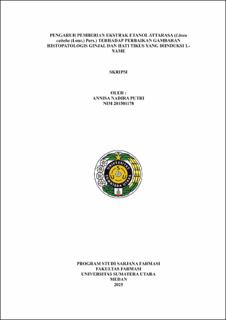Pengaruh Pemberian Ekstrak Etanol Attarasa (Litsea cubeba (Lour.) Pers.) Terhadap Perbaikan Gambaran Histopatologis Ginjal dan Hati Tikus yang Diinduksi L-NAME
The Effect Of Ethanol Extract Of Attarasa (Litsea Cubeba (Lour.) Pers.) Administration On The Improvement Of Histopathological Features Of The Kidney and Liver In L-NAME Induced Rats

Date
2025Author
Putri, Annisa Nadira
Advisor(s)
Dalimunthe, Aminah
Syahputra, Rony Abdi
Metadata
Show full item recordAbstract
Background: Hypertension was a medical condition characterized by a sustained increase in blood pressure in the arteries. This disease can be triggered by various risk factors, such as family history, gender, age, high salt and fat intake, smoking, obesity, and lack of physical activity. If left untreated, hypertension can lead to serious complications such as heart disease, stroke, kidney disorders, liver issues, and eye health problems. The attarasa plant (Litsea cubeba (Lour.) Pers.) was a beneficial plant in the health field that grows abundantly in Balige, North Sumatra. This plant contains flavonoids with high antioxidant properties, which help address the imbalance of reactive oxygen species.
Objective: This study aims to determine the effectiveness of ethanol extract of attarasa leaves in improving the histopathological appearance of kidney and liver organs in L-NAME induced rats.
Methods: An experimental study was conducted using 24 male rats. The hypertension model was established by administering L-NAME at a dose of 25 mg/kgBW orally for 28 days, followed by ethanol extract of attarasa at doses of 100 mg/kgBW, 300 mg/kgBW, and 500 mg/kgBW, along with 0.5% CMC-Na and 5 mg/kgW captopril for 14 days. Histopathological observations of the kidney and liver were conducted using Hematoxylin Eosin (HE) staining methods. Data analysis was performed using scoring methods.
Results: The study showed that treatment with ethanol extract of attarasa at doses of 100 mg/kgBW, 300 mg/kgBW, and 500 mg/kgBW had an effect on the histopathology of the kidney and liver in L-NAME induced rats. Doses of 500 mg/kgBW showed significant improvement compared to the 100 mg/kgBW, 300 mg/kgBW dose and the 0.5% CMC-Na group.
Conclusion: The results of this study concluded that the ethanol extract of attarasa leaves was effective as an antihypertensive agent that can improve the histopathological appearance of kidney and liver organs after L-NAME induction.
Collections
- Undergraduate Theses [1833]
